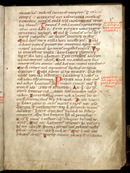
Patristic texts
by Marianus
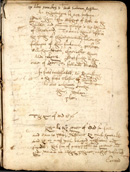
'De origine' by
John Leslie
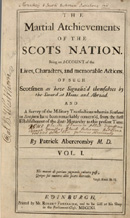
'The Martial
Atchievements of
the Scots Nation'
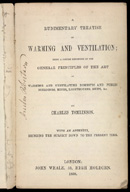
Treatise on warming
and ventilation
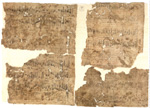
Fragments of
polyphonic music
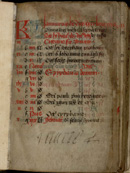
Book of Hours owned
by Mary of Guise
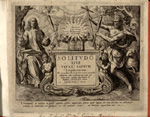
Volume of engravings
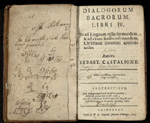
'Dialogorum sacrorum'
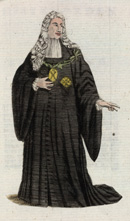
Religious orders

Pluscarden Abbey by
Charles Cordiner

Buffon's 'Histoire
naturelle'

'Greek Menology'

Label inside 'Greek
Menology'
With the help of a generous grant of £329,400 from the Heritage Lottery Fund the Library purchased important books and manuscripts from the collection of St Benedict's Abbey, Fort Augustus.
One of the highlights is a late-11th-century manuscript volume containing the earliest written Gaelic words to be found in any work currently in Scotland. The collection also contains other manuscripts and printed books with a long history of association with Scottish Benedictines.
Read more below about highlights from the collection.
Fort Augustus and Regensburg
The Community of St Benedict's Abbey was founded in 1876 at Fort Augustus at the southern end of Loch Ness. It was a re-foundation of the Irish, and later (after 1515) Scots, monastery of St James at Ratisbon (Regensburg) in Bavaria, which was suppressed in 1862.
One of the most tangible tokens of this link between Fort Augustus and Regensburg was the collection of books and manuscripts which reached Scotland in the early 1860s. Tradition says they were transported there by one of the last two remaining monks at St James's, Father Anselm Robertson. In the late 1870s, these books and manuscripts became part of the library in the new monastery at Fort Augustus.
The Benedictine monks were able to make significant additions to that first collection, attracting gifts from a variety of sources including the neighbourhood and prominent Catholics elsewhere.
Collection purchase
In the course of the 1990s the abbey's manuscripts and early printed books were placed on deposit here in the National Library to benefit from higher levels of security and environmental protection and to provide easier access for researchers.
Following the dissolution of the Community at Fort Augustus, the welcome co-operation of the Trustees of St Benedict's Abbey and the generous assistance of the Heritage Lottery Fund enabled the National Library to purchase the most significant part of the collections offered for sale by the Trustees, thus securing for the nation precious items of the Scottish written heritage.
Complete checklists of the manuscripts and printed books are available for browsing.
Highlights from the collection
Pride of place goes to a volume of patristic texts written in 1080 by the Irish Benedictine monk Marianus, the founder of the Community at Ratisbon. This contains, in Marianus's hand, the earliest written Gaelic words to be found in any work currently held in Scotland.
The manuscripts include some other works originally in the library at Ratisbon. One of these is a translation into Scots, made in 1596 by Father James Dalrymple, of the Latin text of John Leslie's 'De origine, moribus et rebus gestis Scotorum libri decem' (Rome, 1578), important as a Scots language text.
There are 54 printed books known from their inscriptions to have come from Ratisbon.
One such book is Patrick Abercromby's 'The Martial Atchievements of the Scots Nation', vol.1 (Edinburgh, 1711), donated by the author in the year of publication. The title page has inscriptions 'Monasterij S Jacobi Scotorum Ratisbonae 1711' and 'Reverendissimo Placido Flaminio Abbati dignissimo exempti Monasterij S Jacobi Scotorum Ratisbonae dono dedit author libri Patricius Abercromby'.
It is also inscribed by the Order of St Benedict at Westthorn Mills, a Roman Catholic Reformatory near Glasgow where the books from Ratisbon had a temporary resting place.
Other books from Fort Augustus
One book with a Westthorn stamp and the inscription of Father Anselm Robertson, who is credited with having brought the books from Ratisbon, is a copy of Charles Tomlinson's 'A Rudimentary Treatise on Warming and Ventilation' (London, 1858). It is good to be reminded that monks were as worried as the rest of us about keeping warm.
Of manuscripts acquired at a later date by the abbey at Fort Augustus some of the most interesting are the group of 16th-century fragments of polyphonic music from the Inverness music school and a 15th-century Book of Hours that belonged to Mary of Guise, Queen Consort of James V. The Book of Hours was given by Lord Ralph Kerr, third son of the 7th Marquess of Lothian, who also presented six printed books.
Another early benefactor was Brother Basil Weld, a member of a prominent English Catholic family, whose gifts included a volume of late 16th- and early 17th-century engravings which has the additional distinction of having being owned by the architect Viollet-le-Duc (1814-79), the foremost exponent of the Gothic revival in France and restorer of Notre Dame and Sainte-Chapelle.
Scottish items
Rare Scottish books include an edition of Castellion's 'Dialogorum sacrorum libri IV', a collection of Bible stories in dialogue form for schoolchildren and often used as a Latin reader, printed in Edinburgh in 1709: only one other copy of this is known, in the United States.
Also of Scottish interest is 'Afbeeldingen en beschryvingen van Alle Geestelyke en wereldlyke ordens, zedert haare stichting tot op onzen tyd' (Amsterdam, 1791). This book, of which no other copy has been traced, includes a section on the dress and regalia of the Order of the Thistle.
A copy of Charles Cordiner's 'Remarkable Ruins, and Romantic prospects, of North Britain', vol.1 (London, 1788) is an edition not previously held in the National Library: the views include one of Pluscarden Abbey, a Cistercian monastery in the parish of Elgin.
Cordiner's Ruins had earlier been in a private library in the area, that of William Urquhart (1734-1796) of Craigston. Thirty-seven items from his library found their way to Fort Augustus: mostly fine 18th-century books such as an English version of part of Buffon's 'Histoire naturelle' ('The Natural History of the Horse')(London, 1762) with an impressive engraved frontispiece of a horse.
A Greek liturgy
Of slightly different origin is a Greek menology (a liturgical book with lives of the saints arranged by months) that a label, fortunately preserved with the book, shows us to have been presented by one Sergeant Grant, presumably a soldier from the district.
